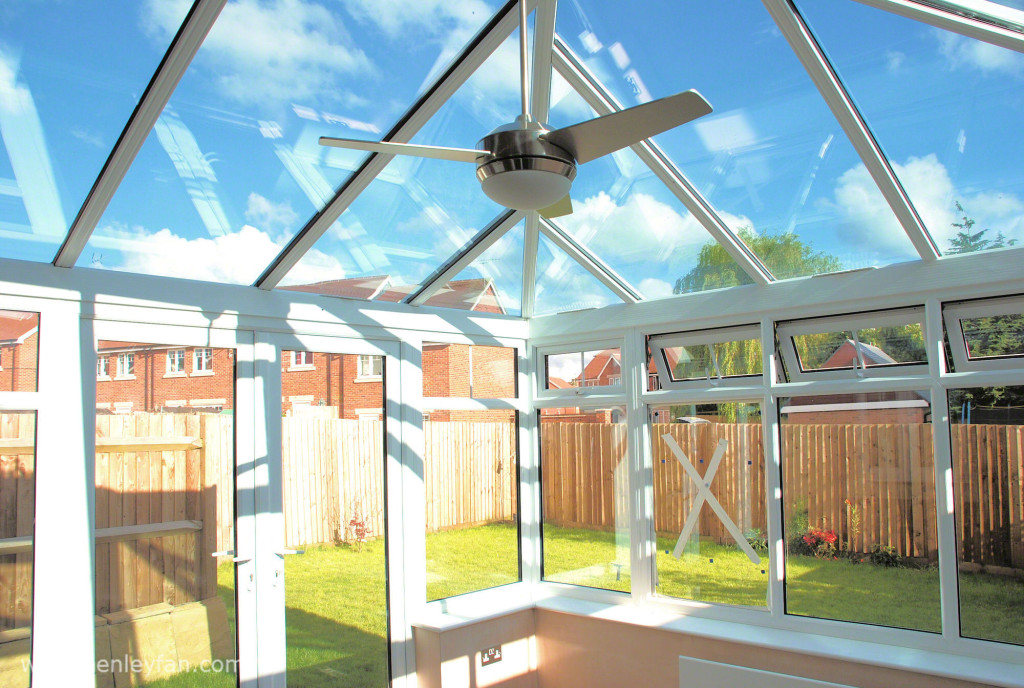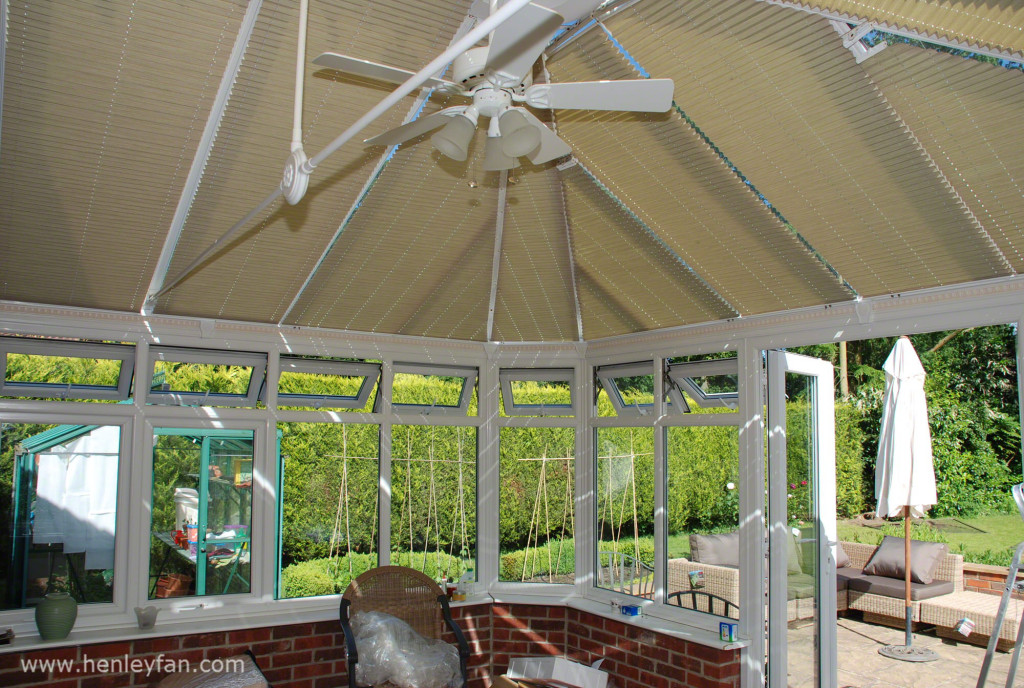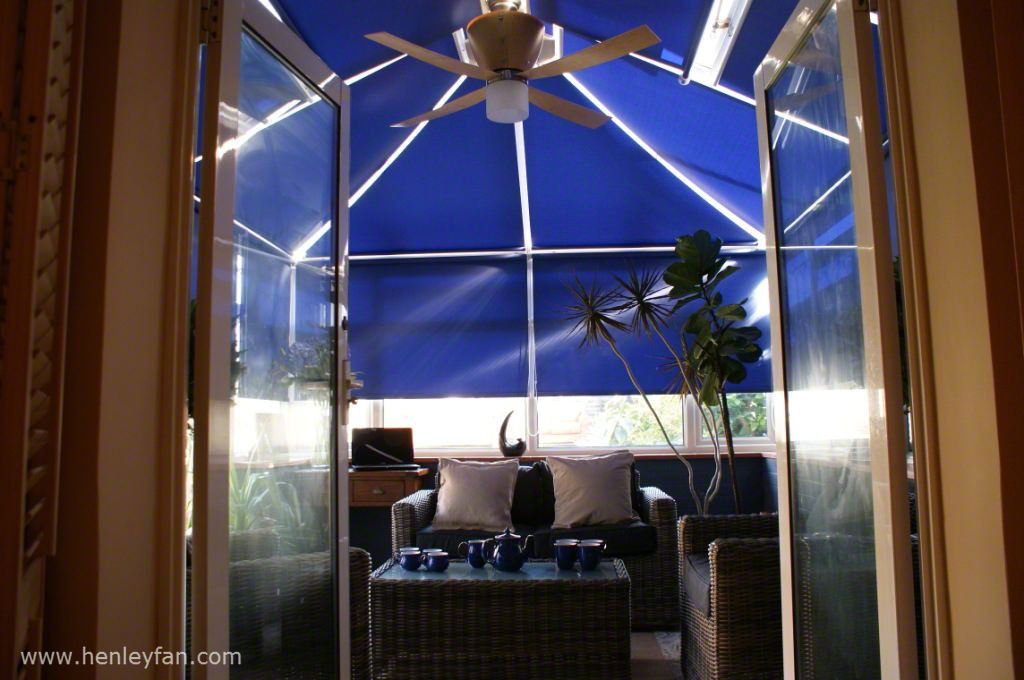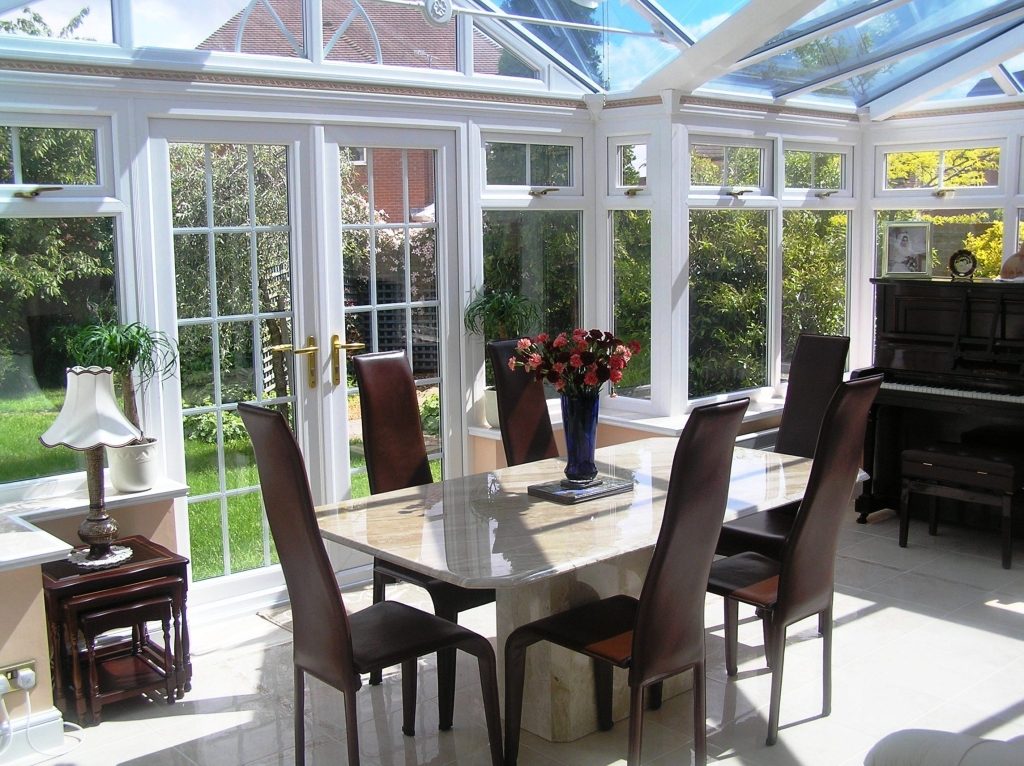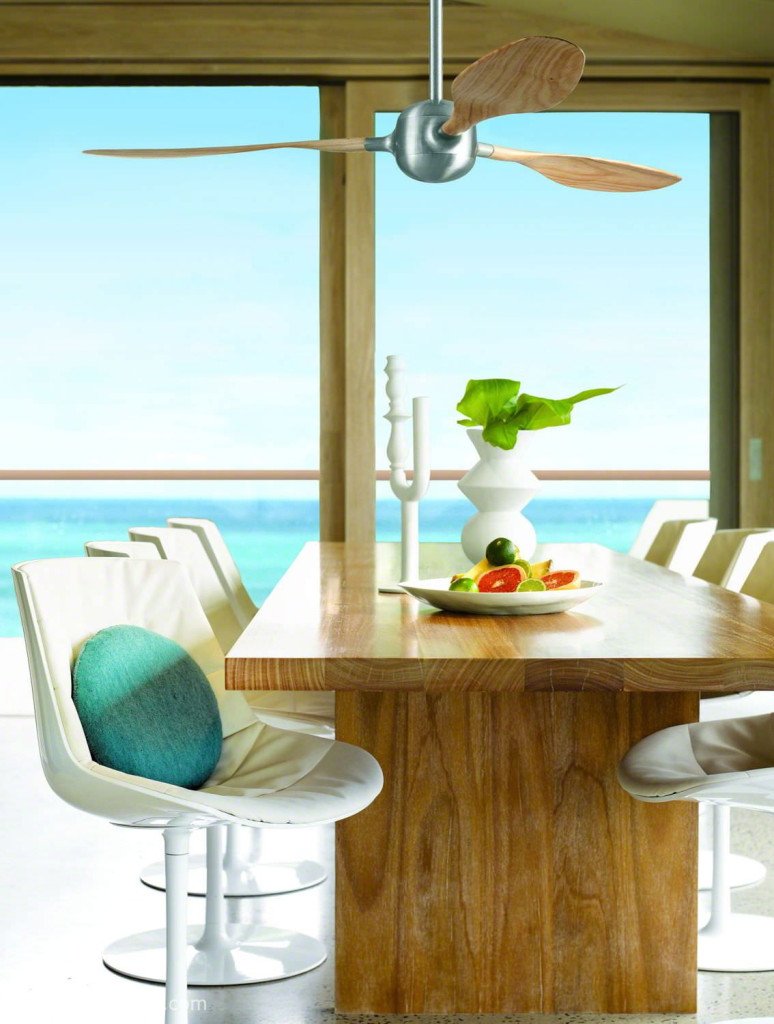How To Select The Perfect Conservatory Ceiling Fan
A ceiling fan for your conservatory can be both a blessing and a curse. When the sun comes out you suddenly realise just how hot it gets in your conservatory. You can open the windows, put in blinds but it still gets so hot and by early afternoon too damn hot! Some people even put air conditioning in but that is a huge unnecessary waste of money. Many conservatories have old, ugly and dilapidated ceiling fans that are broken or noisy making annoying buzzes or hums. Even worse they can be out of balance and wobbling causing more annoyance. They may be too small to be effective and the controls may be broken so it is stuck on one speed. Given how cold and damp a conservatory gets in the winter you need a quality brand that will not be affected by this and work reliably year in, year out without any fuss.
A correctly chosen ceiling fan can not only bring a welcome relief to the heat but can add to the style and focus of the room. When buying a ceiling fan you need to consider a number of important things in order to get the right fan to meet your needs and ensure that you spend your money wisely. Here we will consider just what a ceiling fan can do for you and exactly what those considerations are.
How A Conservatory Heats Up
A conservatory works like a greenhouse trapping UV and infrared heat radiation even if outside is cool or overcast. The floor and bricks inside also warm up and give off convection heat which then adds to the head from the incoming radiation to make it get hotter and hotter as the day goes on. The hot air rises and gets trapped under the roof. It is thus essential to have vents at the top to let this hot air out. If you don’t then opening windows might let some of this heat out if there is a breeze outside otherwise it will tend to just sit there.
Three Ways A Ceiling Fan Cools A Conservatory
There are three significant ways that a ceiling fan can reduce and remove the unwanted heat from a conservatory:
- Direct skin cooling – by virtue of the “wind chill effect” of air moving over the skin a cooling effect of 3-4°C is achieved. For this smooth laminar airflow is required rather than turbulent buffeting flow which also feels more pleasant. In humid conditions the effect of just having air moving over the skin is fantastic since hot humid still air is so unpleasant.
- Removal of heat – the hot air can be quickly moved away from the warm surfaces by a ceiling fan, thus cooling it down. The problem is that unless a window is open then there is nowhere for this hot air to go which means you will simply get hotter and hotter, so it is important to open a window. The ceiling fan will then draw in cooler air from outside due to the airflow around the room. Note that it doesn’t have to be blowing directly out of a window like an extractor fan, the way the air moves creates zones of lower pressure near the windows that simply draws in air from outside. Given that the greenhouse effect can easily cause temperatures inside to rise to 40°C or more this will make a big difference. One tip is to open the windows and turn the fan on early in the day to prevent any build up of heat.
- Night-time dissipation – this is where a real bonus can be achieved. Since night-time air temperature can drop significantly even in hot climates the trick is to leave the windows open all night with the fan on slow speed in reverse. The aim is to release all the of the absorbed heat in the solid materials of the floor and walls which if left warm overnight will get even hotter the next day. These materials act as a store of heat energy and by circulating cool air over them through the night all this energy is dissipated leaving a store of “coolness” to operate the next day. Solids heat and cool very slowly so this works very well and can be almost as effective as having air conditioning but without the cost.
Ceiling Fan Buying Considerations
There is a lot of what can at best only be described as junk out there, so before purchasing a ceiling fan please consider the following technical factors:
- Reliability and Warranty – A conservatory ceiling fan is something you want to last for many years so look for a reputable reliable manufacturer who gives a minimum of 10 years guarantee. Fantasia offer a 5-10 year guarantee on most of their fans. B&Q offer a 1 year warranty. You might think that is is overkill to have a Lifetime Warranty as you will not live in your house for ever but it is more a stamp and sign of quality of manufacture. It is worth investing a bit more for this since a manufacturer isn’t going to offer that and than make a poor quality product. On the market there are only 5 brands that offer a Lifetime Warranty – Hunter, Minka Aire, Matthews, Star and Henley Fan. All of these brands are stocked by us. All of these companies have been around for decades so the warranty actually means something. Anyone can offer a Lifetime Warranty but it is of no value unless they are still in business when you need it. Hunter Fan for example is the oldest and largest ceiling fan manufacturer who have been around 125 years. It is important to note that the warranty almost always applies to the motor only and not to the blades. Neither does it apply to the light kit or remote control which are usually just 1 year’s warranty nor to the finish.Below is a shot of the unusual Hunter Valhalla ceiling fan taken from ITV’s 60 Minute Makeover.
Ceiling Fan Buying Considerations Cont.
Dampness – Whilst in the spring and summer months your conservatory can get unbearably hot in the winter it can get cold and damp especially if there is no heating on. This will surprisingly quickly lead to corrosion setting in which will affect the motor laminations (which are steel), the finish and the blades. Cheap metallic finishes are likely to start to pit, crack and flake off within 2 years. Blades can start to warp if made from hardboard, MDF or other cheap materials due to the effects of moisture. This warping will make the fan unbalanced causing it to wobble making an annoying noise.
- Performance – How many blades should I have? There is a lot of misunderstanding on this point. Less blades actually more move air per watt of power since there is less overall drag and so are more efficient but for a given speed more blades will move more air which means less noise. Looked at from the other perspective for a given airflow less blades need to move faster and so make more air noise, create more drag and are less efficient. The other important consideration here is that the airflow needs to be laminar and NOT turbulent which feels uncomfortable on the face. Laminar airflow is where you get a gentle smooth airflow from a slow rotational speed (in engineering terms where the Reynolds number is less than 2,000). In reality there is not much difference between 3, 4 or 5 blades so the choice should come down to appearance and style.
- Blade Size – The bigger the blade size the more air is moved and the more energy is consumed. However a larger blade running at a lower speed is much quieter than a smaller blade running at a high speed. Typical sizes are 42″ (107cm) and 52″ (132 cm) but for very small rooms you can get a 36″(92 cm) size and for very large rooms look for 56″, 60″ or even bigger. Look at each manufacturer for the span of action of a fan so you can size up how many you need to cover a large rooms. In small to medium sized rooms 1 properly sized fan should be sufficient.
- Speed – Most fans operate at 3 different speeds. Speed interacts with size and power (see previous point). Speed is controlled by either a gearbox (in rare situations) or more usually by a thyristor/capacitor and microchip controller. The latest low energy DC invertor controllers are more accurate and can give 6-speeds saving up to 70% of the energy over an equivalent AC ceiling fan. The early models were susceptible to voltage variations and spikes leading to unreliable operation. The second generation DC controllers are extremely robust so make sure when you buy a ceiling fan that it uses the second generation technology. Here the use of cheap components can lead to annoying buzzes and premature failure of the fan motor.
- Features – Better manufacturers such as Hunter have many patented and useful features such as wobble free canopy mounting systems, low energy motors, easy installation systems etc. Preventing wobble is essential to reduce noise to a minimum which can be very annoying especially if the fan is going in a quiet room such as a bedroom. DC motors are completely silent plus can be run at very low speeds (as they have a 6 speed control) and so ideal for bedrooms.
- Build quality – Cheap manufacturers will use cheaper components that will fail much quicker often just outside the 1-year warranty period. At the core of a ceiling fan is the motor – one moving part – so not much to go wrong? Wrong! A cheap speed control capacitor can easily fail after 18 months or sooner and can start buzzing long before it gives up. Cheap motor laminates can buzz and fail and unless the copper windings are encased properly in resin can corrode and short leading to motor failure. This is especially important in conservatories where the ambient temperature at night can fall below the dew point causing moisture to condense onto the motor which in turn will lead to corrosion and failure. Blades need to be made not from cheap cardboard or hardboard but proper plywood, ABS or seasoned or compressed solid wood to avoid twisting.Below is a photo of the fashionable Kitchler fan.
Ceiling Fan Style
Today there are so many styles and finishes to choose from there is something for everybody’s taste and to cater for every sort of room. From traditional to contemporary, art nouveau to swish and stylish designs the ceiling fan can become a center of focus for the room as well as providing the essential function of cooling. The latest fashionable designs from brands such as MrKen and Matthews-Atlas tend to be have a sleek simple minimalist look and utilise either plastic ABS or solid wood blades neither of which warp over time. B Henley Fan provide an amazing wide range with 50 different models in 35 different finishes!
Prices Of Fans
We all love a bargain but don’t be duped and waste your money on a ceiling fan that isn’t going to last a minimum of 10 years. You may not be planning to stay in your current home that long but it is about the build quality. It is a false economy to go cheap since you will spend time and a lot more money getting an electrician to fix it when it goes wrong and having to replace it. A £25 ceiling fan from B&Q really is a waste of money and is like buying cheap wine. Since the portion of the price that actually went to manufacturing the product itself will be less than £5 you will not get a lot of ceiling fan, and the quality will be so low as to be meaningless. It may last a year if you are lucky but will almost certainly start humming long before that due to the cheap components used (cheap capacitors, windings, laminates etc).
Below is an image of the stylish Lucci-Beacon Woody outdoor fan.
Fit and forget is the best policy so go for one of the reputable branded names such as Hunter, Minka Aire, Matthews, MrKen, Cassablanca. They will also have all the essential accessories such as light kits, remote controls, drop rods and provide you will full backup should anything go wrong. To find out more go here. There are a number of big retailers who have recently entered into the market such as Wayfair and ebay (watch out for very cheap 110v models that won’t work in the UK). They will typically have a limited choice of older models and aim to sell by discounting. They won’t have any real expertise beyond the basics that they read from a script. They will not be much use should things go wrong. You can save a bit of money upfront but will pay for it later. Your local electrician can source a fan from his usual trade supplier but these tend to be very limited in choice and of low quality. It is much better and safer to go to a specialist retailer. You will pay a little bit more but get a great selection of the latest models from a wide selection of brands and great knowledgeable service. You also have the assurance that if anything does go wrong you have a great after-sales service to call on.
Here you can create the content that will be used within the module.

